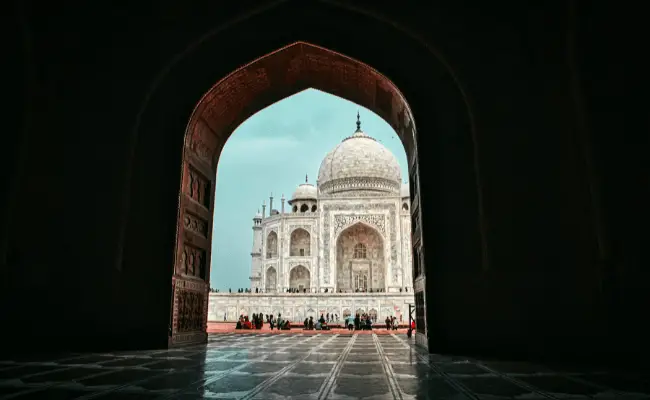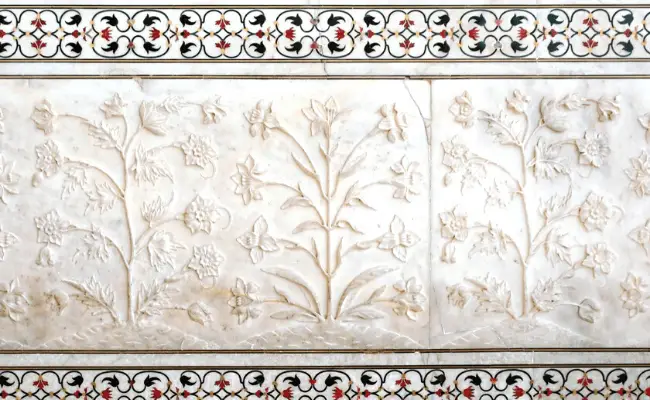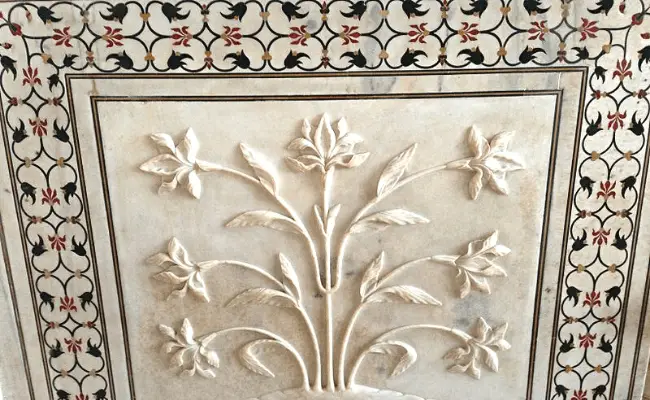The Taj Mahal is a symbol of immortal love, a magnificent tomb created by the Mughal Emperor Shah Jahan, on the banks of Yamuna River Agra, for his beloved wife, Mumtaz Mahal. A council of the best architects was assembled to prepare designs for the tomb. Though some attribute the design to Geronimo Verroneo, an Italian in the Mughal service, evidence suggests that it was designed by Ustad Isa Khan Effendi, a Persian, who assigned the detailed work to his pupil Ustad Ahmad. The dome was designed by Ismail Khan. It is, without doubt, the most famous example of Mughal architecture to be seen.
The tomb is higher than a modern 20 storey building and took 22 years to complete, with a workforce of 20,000. Craftsmen from as far as Turkey came to join in the work. The marble was quarried at Makrana near Jodhpur in Rajasthan. Precious stones were imported from distant lands. A ramp of more than 3 kilometers was built to lift material up to the level of the dome. It is said that on its completion, Shah Jahan ordered the right hand of the chief mason to be cut off that the masterpiece could never be recreated!
The uniqueness of the Taj Mahal lies in its many details in the masterly contrast between the central dome and the slender minarets, in the chaste refinement and painstaking craftsmanship, and above all in the splendor of its materials. The design of Taj is more Persian and less Indian than any building we have encountered, but it is again difficult to find anything of Taj’s stature in Persia.

Visitors to the Taj Mahal will discover exquisite gardens and canals above which towers the massive form of the mausoleum. At the intersection of the canals, the shimmering waters of a wide ornamental pool reflect the silhouette of the Taj Mahal. The outlines of the tall, elegant cypress trees create a subtle symmetry to the whole view.
The main entrance is from the west, but there are two other entrances, from the east and the south. The main gateway is a large three storey sandstone structure with an octagonal central chamber with smaller rooms on each side.
The Makrana white marble of the Taj Mahal assumes subtle variations of light, tint, and tone at different times of the day. At drawn it assumes a soft dreamy aspect. At noon, it appears to be a dazzling white, and in the moonlight, the dome looks like a huge pearl. Not surprisingly, then, the Taj is today regarded as one of the most beautiful in the world!
Why does the interior of the Taj Mahal delight the eye?

The interior of the Taj Mahal was provided with sumptuous fittings and furnishings, including rich Persian carpets, gold lamps, and candlesticks. Everywhere you look there are precious and semiprecious gemstones.
The inner chamber is an octagon with a design allowing for entry from each face. The interior walls are about 25 meters high and topped by a ‘false’ interior dome decorated with a sun motif. Eight arches grace the space at ground level. Soft light filters through latticed windows and filigreed marble screens to light up the bejeweled inlay work with a magical radiance.

The decorations are in form of floral designs. Above these beautiful floral patterns are extensive calligraphic inscriptions in black lettering. Most of the text is short verses from the Qur’an. These floral motifs are sculpted in marble in sober relief or inland with semiprecious stones that produce shimmering reflections.
There is not a single spot in the Taj Mahal that is not artistically wrought with its own beauty. Even the black and white floor tiles are chosen with great care and are extremely beautiful to behold.
Recommended Video: TAJ MAHAL (Agra, India): Full Tour
Recommended Reads:
